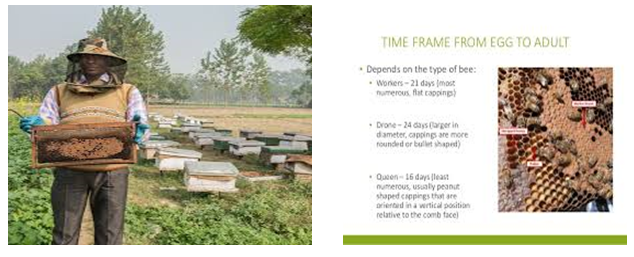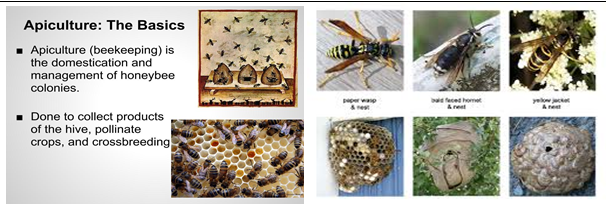Authors: *Sharwan Lal Jat , **Dr. S. Singh, *** Dr. Rajdeep Mundiyara and **Dr. B.L.Jat
*Professor Division of Entomology, R.A.R.I. Durgapura, SKNAU, Jobner
**Professor Department of Entomology, SKNAU, Jobner, Jaipur
***Ph.D Scholar Department of Entomology ,SKNAU,Jobner,Jaipur
Seed Officer Rajasthan State Seed Corporation Ltd., Jodpur
*Corresponding other Email. sharwanento@gmail.com
Apiculture or beekeeping is the art of cultivation of honey production, bee wax, royal jelly, propolis and bee vomen which has significant value from medicinal as well as commercial point of view. Beekeeping can be a treated as a hobby, profitable venture or as a medium for entrepreneurship development. Being the source of sugar, vitamins, protein, minerals and having substantial medicinal values, increased consumption of honey has created opportunity for farmers to become beekeeper.
Honey bees are the social insect, live in the well organised family consisting of several thousand workers, drones and a single queen. India is bestowed with the most important species of bees likeApis dorsata, Apis cerena indica, Apis florea and Apis mellifera that rewards you with surplus amount of honey. Among these, Apis cerena and Apis mellifera species are concentrated in the northern states of the country like U.P., M.P., Rajasthan, Jammu and Kashmir, Himachal Pradesh, Haryana and South India states Apiculture as such doesn’t require a big investment in terms of money, time and space.

Basic components/accessories required
- Smoker and hive tool: Smoker consists of a metal fire pot and grate with bellows attached. The hive tool is a metal bar used for prying apart frames in a brood chamber, separating hive bodies and scraping away wax as well as propolis.
- Hive: A man made construction for keeping bee colony. It consists of a series of boxes or hive bodies with suspended frames containing foundation and brood nest separated from the honey supers (where the surplus honey is stored) with a queen excluder.
- Bee brush: It is a whisk broom used to brush off bees from honey combs before it is taken away from extractor.
- Protective clothing: To protect your face and neck from stings during honey separation.
Livelihood of bees is strongly affected by temperature. Workability of the bees reduces and they could not fly at temperature below 13°C and when it reaches above 40°C. Semi-arid region in Rajasthan is quite suitable for beekeeping as the temperature ranges here in between 16-39°C during most of the days of winter and summer season.
Site selection
Both the established and beginners should select hives site at short distance from the sources of nectars (honey) and pollens. Pollens are the need for brood rearing, while nectar is the bee’s basic source of energy. In order to produce high large honey crops, the site should
have dense floral sources. It should have abundant water supply to dilute honey, regulate hive temperature, liquefy crystallized honey and raise the brood. It should be situated near the natural wind protections, on the dry ground and have good air drainage. The colonies exposed to south or east gives maximum sunshine throughout the day.

Management
- Reserves of nectar, laying pattern of eggs/pest and disease attack should be observed on regular basis
- After the end of rainy season, monitoring is very important to avoid the crowding of bees. It can adversely affect on the yield of the surplus.
- Colonies should be checked regularly after 15 days interval.
- Since rainy season is difficult for bees, avoid excess handling against disease and feeding of the colonies during the particular period.
- During summer season, queen usually lays eggs on the upper box which should be shifted to the lower boxes and honey reserve to the upper box.
Honey is generally ready to harvest when 75% of the frame gets filled with honey. Supers should be removed and honey can be extracted using stainless steel extractor without exposing the frame to the direct sunlight. Some honey should be kept reserved for the bees. Care must be taken that smoking must be done at slower rate and not using excessively.
Immediately after harvesting, honey should be heated and filtered to remove the debris and other extraneous matter. It must be placed in the settling tank for further extraction of moisture. Filtered honey is then packed in the clear glass or plastic container and stored in a warm, dry place or freezer.
Applications
Being a natural sweetener and comprising about 80% sugar, honey can be used in the bakery, confectionary and beverage industries. It not only adds taste to the foods but it is a source of high energy carbohydrate and is easily digestible. It can be consumed in the form of table honey or can be used as an ingredient to candies, cakes, cooked foods and juices. A daily consumption of one spoon fresh honey is very effective for constipation, hyperacidity and obesity.
Wax secreted by the worker bees can be used as desiccants and coating material for fruits and medicines like sugar coated pills. The diverse area of its use includes manufacturing of insulations, waxing materials, oil for anticorrosion and wax paper.
The royal jelly secreted by young bee is the source of moisture, protein, sugar, lipids and mineral salts. It is claimed that it can be used as tonic to increase appetite resistance to viral infections, controls the cholesterol level and low and high blood pressure
Recent advancement: Flow-Hive Technology
Flow high is the revolutionary technology of Australia that allows harvesting of honey without opening the hive and disturbing the bees. It consists of flow frame composed of plastic comb having deep cells to be filled with honey, and cap. The hose is fitted at the base of the frame and a bent metal rod inserted at the top. On turning the rod, to sides of the flow frame slightly move towards the middle, allowing the honey in the cell to flow down through the channels. Then the honey can be easily harvested through hose by opening the tap. This will definitely make the honey harvesting more easier and saves lots of effort and time.

Conclusion
Apiculture is one of the satisfied subsidiaries that can be practiced professionally which has capacity to boost the secondary income of farmers. Because of having assured irrigation supply and availability of good flora in Rajasthan some Distt. Alwar, Bhartpur, Dusa, Kota,Swai madupur, beekeeping has a potential to improve the socio-economical status of the marginal farmers. Nandbai and Village Industrial Commission has been engaged in the research, development, extension, training, marketing and financial assistance to promote the apiculture in rural areas. Apiculture has a tremendous scope for value addition in by products to increase the income and can be followed as a family business on small as well as large scale.
References:
Atwal, A.S. 1964. Introduction of black Italian queens in indica hives. Apicolt ital.3(4):100- 101.
Bhat P and Kolatker M.Technical Report No.124.Centre for Ecological Sciences, Indian Institute of Science, Bangalore (2011) .
Farrar C.L., Productive management of honey bee colonies, Am. Bee J., 133(4), 261-263(1993 d)
Singh G., Present status and future of marketing of Indian Honey in domestic and international market, Proc.Conf.Forest based industries, Pune 40-41 (2008)
About Author / Additional Info: